6 different types of cameras for photography explained
by Alex W.
Have you outgrown your smartphone and want to upgrade to a camera with a bit more flexibility but find yourself overwhelmed by all the talk of the different types of cameras?
So do you want a bridge camera, a DSLR or maybe a mirrorless?
And what’s this about Micro Four Thirds? What does all this stuff even mean?
Here is where you confusion ends.
We’ve put together this simple guide to all the major types of cameras out there in the modern era, along with some easy to digest pros and cons for every one of them.
So, without further ado, let’s jump straight in and narrow that camera search down.
Sensor size and why it matters
Before we get straight to the types of cameras, it’s important to know the role that sensor size plays.
Why? Because the size of the sensor will be either a pro or a con for many of the different camera types.
Sensor size does what it says on the tin: It’s the physical size of the sensor.
Ever wonder why a 16 megapixel DSLR will outperform a 24 megapixel smartphone? Sensor size plays a huge part in that (among other things).
If all else is equal in terms of resolution, a bigger sensor means that each individual pixel is bigger. This makes each pixel more effective at gathering light, which makes them much better at capturing high contrast scenes or difficult lighting conditions.
There are a number of other things sensor size affects, such as depth of field and ISO performance, but the gist of it is this: A bigger sensor usually means better image quality, but it also means increased size, weight and cost. It’s basically a trade-off between quality, performance and cost.
Here’s a handy chart of the different sensor sizes compared, and below that you’ll find a bit of info on each of the widely used sizes.
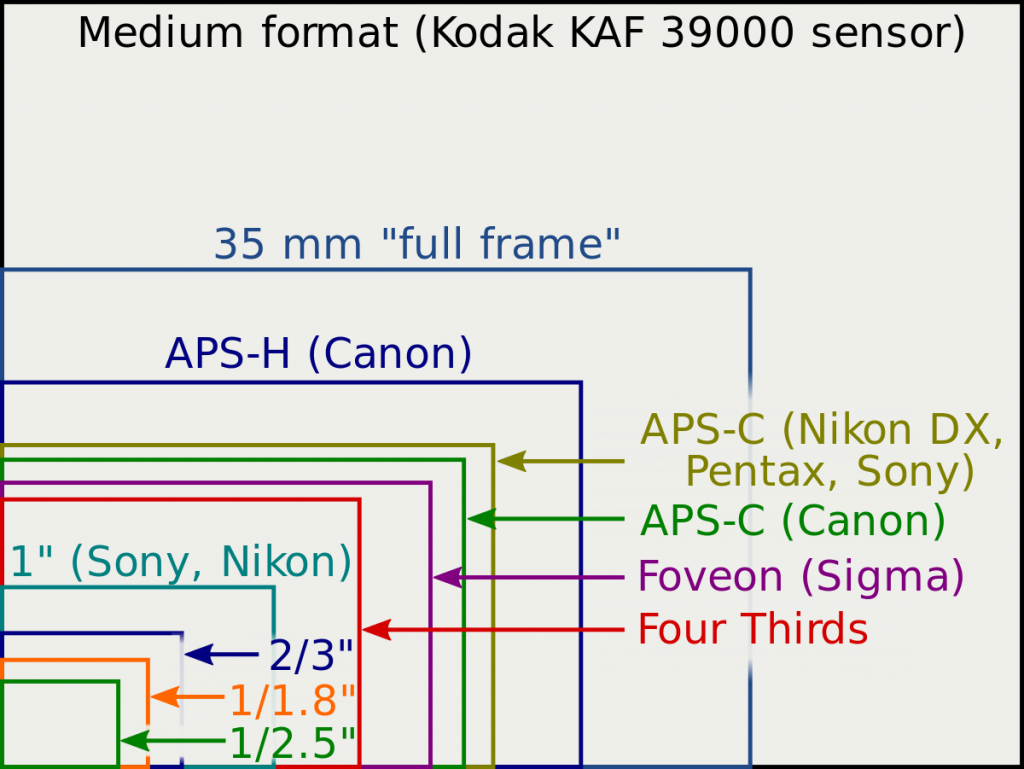
- 1/2.5″ – This is around the size of sensor used in most smartphone cameras, although this does vary between phones.
- 1″ – Many compact cameras and lower end photography drones use a one inch sensor.
- Micro Four Thirds – This is the beginning of interchangeable lenses. Slightly bigger than a compact camera sensor, Micro Four Thirds is a system dominated by Panasonic and Olympus.
- APS-C – Most entry-level and intermediate DSLRs and Mirrorless cameras utilize this and it’s generally big enough for all but the most demanding of photographer.
- Full-Frame – Named so because its 35mm measurement matches the size of film in analog cameras, full-frame cameras are aimed at professionals who want the very best in terms of image quality.
- Medium Format – Aimed at photographers who want to produce huge prints, but the immensely high cost and cumbersome size and weight makes them an unfeasible option for 99% of the photography world.
Types of cameras explained
DSLR cameras
Major players: Nikon, Canon
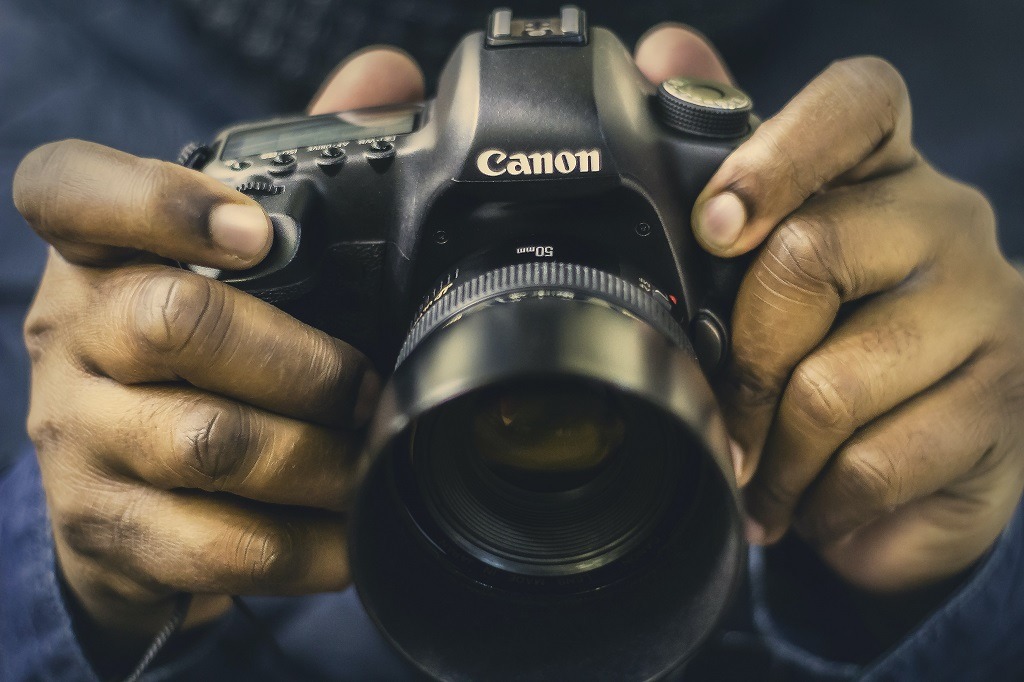
Still the most commonly recommended step up from a compact camera or a smartphone, the DSLR market is huge.
Canon and Nikon are the two big players, and both offer a wide range of cameras to cater to every type of photographer.
They go all the way from budget friendly entry-level APS-C models to beasty full-frame professional gear, and because they’ve been around for so long now there is a massive range of lenses for both Nikon and Canon available.
DSLRs are the cameras most people visualise when they think of a ‘proper camera’, and they’re likely to remain at the forefront of the beginners market for some time thanks to their affordability and versatility.
That being said, the rise of mirrorless technology has resulted in the DSLR market dwindling somewhat, with both Nikon and Canon finally moving into the mirrorless area for the first serious time last year.
You can find a range of the best DSLR cameras for beginners here.
Pros
- Huge range to choose from all the way from complete beginner to seasoned pro
- Established technology means bargains can be found
- Massive amount of lenses available
- Most affordable way in to ‘serious’ photography
Cons
- Declining in popularity due to mirrorless rise
- Bigger and heavier than mirrorless counterparts
Mirrorless cameras
Major players: Sony (A Series), Fujifilm (X-Series), Nikon (Z Mount), Canon (EOS R and EOS M)
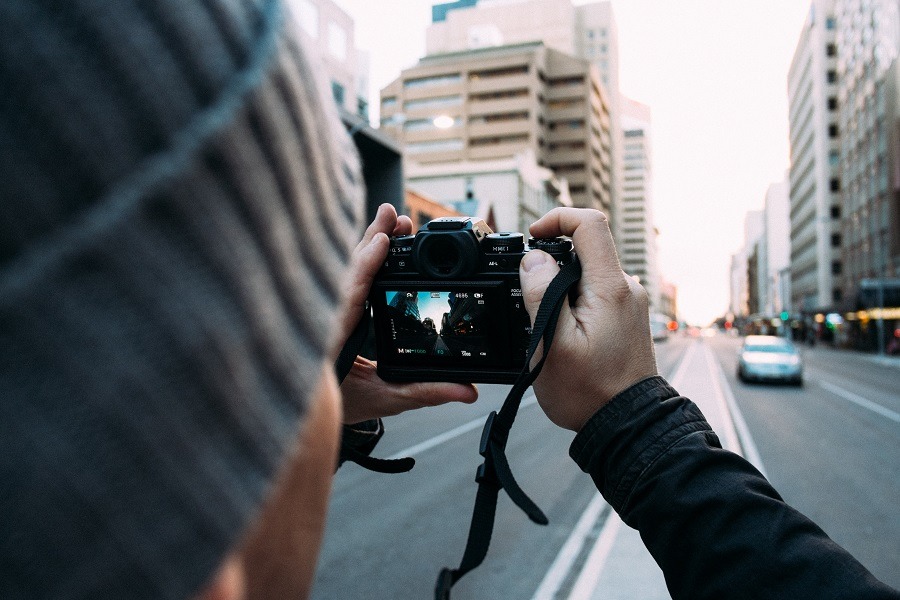
Technically, cameras such as the Micro Four Thirds and action cameras below are mirrorless (simply because of their lack of a mirror), but when most photographers refer to ‘Mirrorless cameras’ they’re usually talking about a specific type.
That type is the DSLR challengers. The ones with APS-C or full-frame sensors that offer all the performance of a DSLR but with a few benefits and a few drawbacks.
The high end Sony cameras are widely considered to be the peak of mirrorless powers, but Fujifilm’s extraordinary quality makes them a popular choice and the relatively new Nikon and Canon arrivals are growing in stature.
One of the major benefits is the reduced size and weight of a mirrorless system. The removal of the mirror box of a DSLR drastically reduces the size of the camera and that, combined with the reduced size of the lenses, make the entire system a much more travel-friendly option.
That’s exactly why I recently switched my entire full-frame Nikon DSLR system for a Fujifilm X-Series.
Reduced size isn’t the only advantage mirrorless has over DSLRs. Generally speaking, mirrorless cameras get the benefit of new technology sooner than their bulkier counterparts and often bring new features to the table such as 4k photo modes, ridiculously fast burst shooting, in-body image stabilisation and improved support for videographers.
There are drawbacks as well, though.
For example, the removal of the mirror means the viewfinder (if the camera has one at all) is an EVF (Electronic Viewfinder), which is basically a digital depiction of the scene viewed directly from the sensor. This does have benefits such as being able to see exactly what effect a change in settings would have, but it also means reduced battery life and some lag when capturing high-speed subjects.
EVFs have improved massively over the last few years, but they’re still not quite the same as a straight up optical viewfinder.
Another drawback is the cost. Mirrorless technology is still relatively new compared to the finely honed DSLR cameras, so a mirrorless camera is going to cost more than it’s DSLR equivalent. The freshness of the system also means lens choice isn’t on the same level as DSLRs.
Want to read more? Here’s our guide to choosing between a DSLR and a mirrorless, and if your mind is already made up take a look at our favourite mirrorless cameras for beginners.
Pros
- Smaller and lighter than DSLRs without compromising on quality
- Technology improving all the time
- Usually gets new featured implemented sooner than DSLR counterparts
Cons
- More expensive than equivalent DSLR
- Reduced battery life
- Lens choice not quite as big as DSLR
- EVF can be a con depending on which side of the fence you’re on
Micro Four Thirds cameras
Major players: Olympus, Panasonic
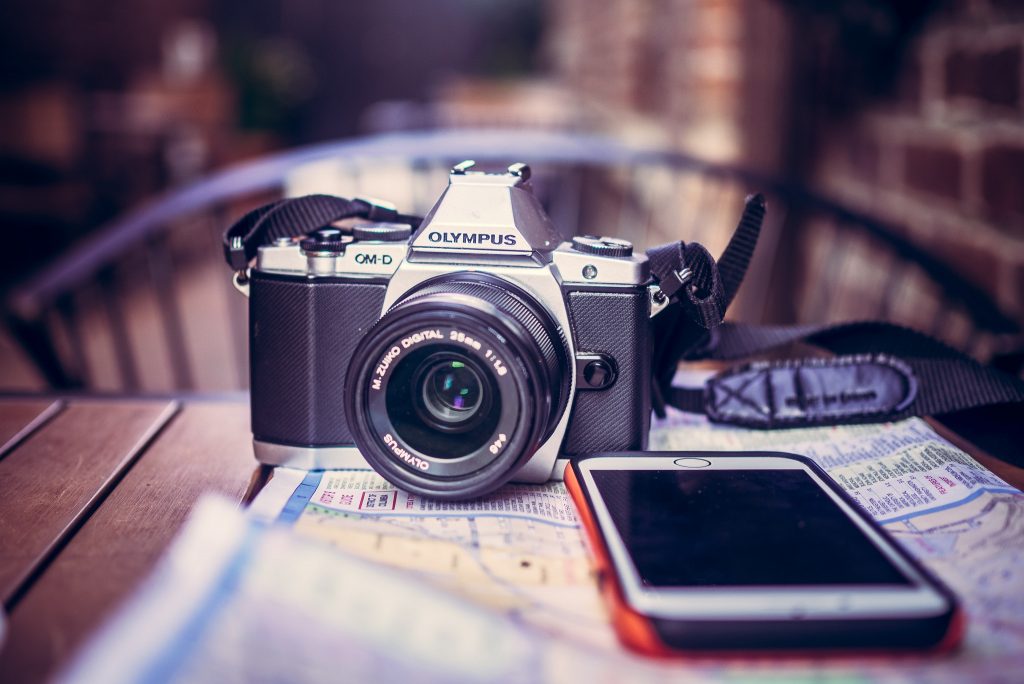
Micro Four Thirds is a system developed by Olympus and Panasonic, with the name referring to the size of the sensor.
This system is seen as the first major step up from a smartphone, bridge camera or compact camera because of the ability to change lenses, and the huge selection of lenses is one of the major advantages of this type of camera.
Because all Micro Four Thirds cameras share the same lens mount, both Olympus and Panasonic (along with a few third-party manufacturers) have produced a massive array of lenses from cheap and cheerful superzooms all the way up to professional quality glass.
The sensor is smaller than the DSLR and Mirrorless camera types discussed above, but still large enough to produce impressive image quality providing you’re not shooting in massively demanding conditions.
While this reduced sensor size does have an impact on image quality, it balances the scales with the ridiculously portable nature of the system.
Micro 4/3 setups are tiny. If you choose the right camera body and lens you can easily fit your whole setup in a jacket pocket, and this makes them perfect for travel photographers who don’t want to be weighed down with a ton of camera gear. Their size also means they’re discrete, making them a popular choice among street photographers who don’t want to be noticed.
Being mirrorless systems, they also carry the advantage of seeing the latest camera technology before DSLR bodies. 4k photo mode, 6k video shooting, in-camera stabilisation and high-resolution photo stacking have all been pioneered by Micro Four Thirds cameras.
This system also carries some of the very best in videography technology advancements, so if you like to shoot videos as well as photos a Micro Four Thirds system could be right up your street. You can find our favourite Micro Four Thirds cameras here.
Pros
- Incredibly small and light
- Huge lens selection
- Pioneering technology
- Excellent for videographers
Cons
- Sensor size does effect image quality
- Expensive if you want high quality lenses
- Many bodies lack viewfinders
Bridge cameras
Major players: Sony, Panasonic, Nikon, Canon
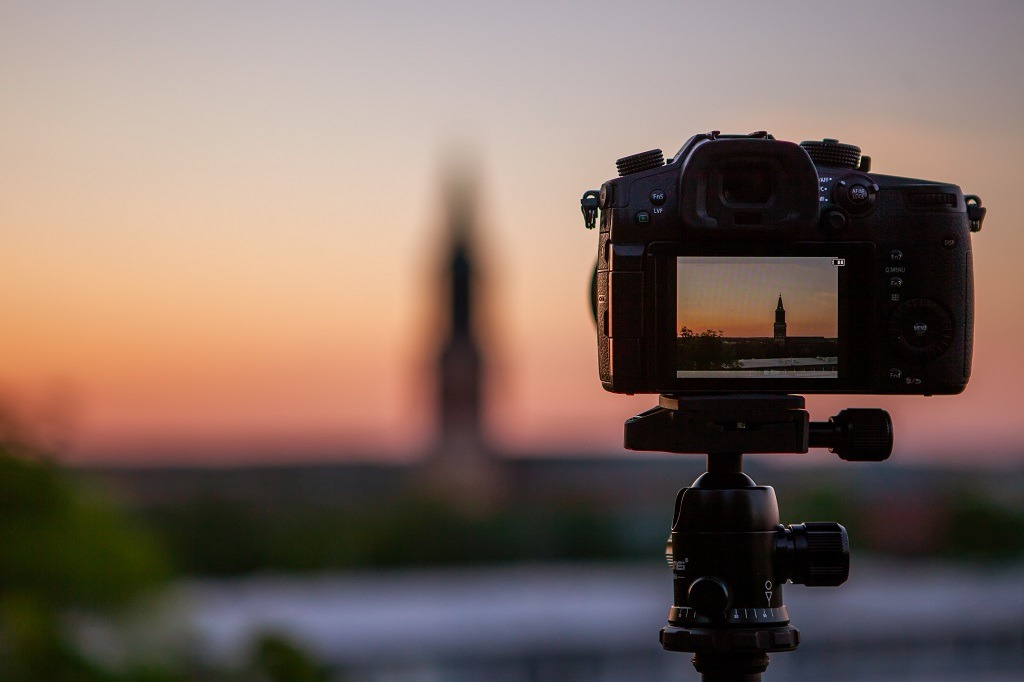
Bridge cameras slot in nicely between a small point and shoot camera and the more advanced Micro Four Thirds, Mirorrless and DSLR options.
They come at attractive price points and generally offer the photographer more control over their shots, with manual controls as well as more advanced features than compact cameras.
Bridge cameras range from DSLR-style bodies at entry-level price points all the way up to impressively high quality superzoom cameras that cost as much as a mid-range DSLR.
For example, the budget-friendly Panasonic FZ330 has a small 1/2.3″ sensor and a zoom range of 25-600mm equivalent, while the more expensive Nikon P1000 offers the same sensor but has a ludicrous 24-3000mm zoom range. Meanwhile, the even more expensive Sony RX10 IV inches into four figures in cost but does offer an improve 1 inch sensor.
While these are definitely a step up from your standard compact camera or smartphone, the unavoidable drawback is the fact that these aren’t interchangeable lens cameras. You’re stuck with what you’ve got, and some of the higher end models are by no means small investments.
The sensor size is also a drawback for many of the lower end models, with the only real advantages over a smartphone being the optical zoom lens and the increased control over the settings.
Pros
- A step up from lower end compacts or smartphones in terms of features and versatility
- Some offer incredible zoom capabilities
- Impressive image quality on higher models
Cons
- No interchangeable lenses
- High end models very expensive
- Small sensor size
Compact cameras
Major players: Nikon, Canon, Sony, Fujifilm, Panasonic, Olympus
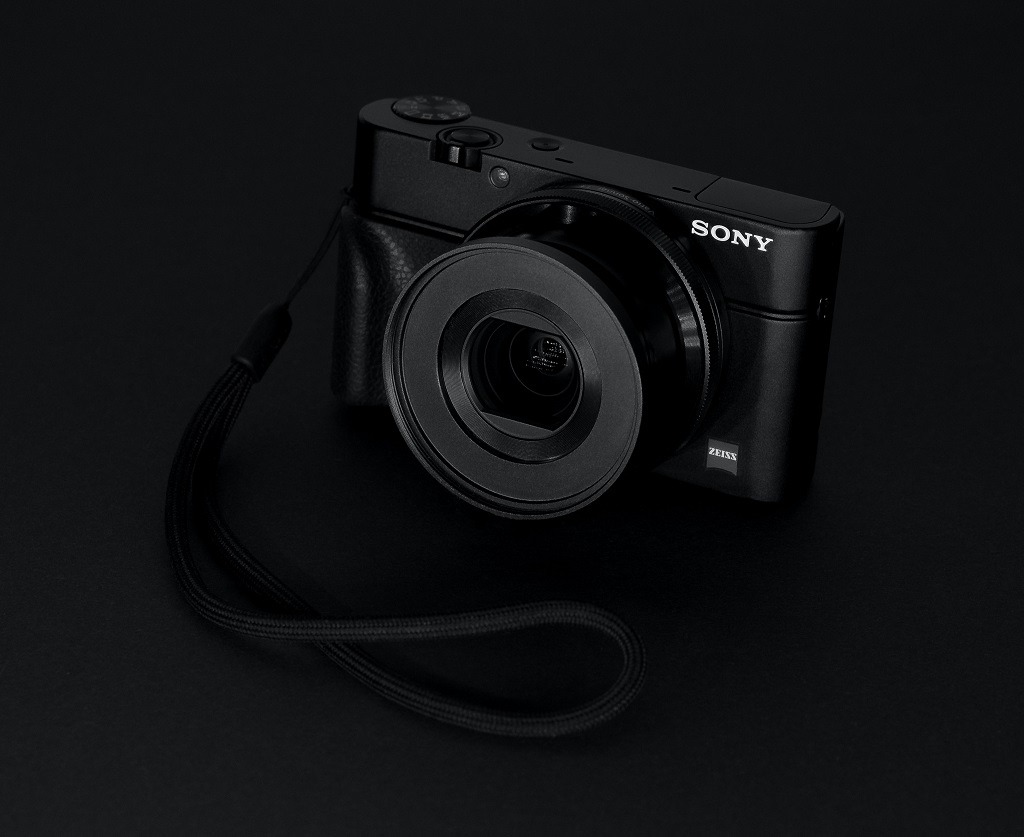
While most bridge cameras offer superzoom capabilities as their main selling point, compact cameras fall into two distinct brackets: There’s the budget friendly beginner models, and then there’s the high quality but extremely portable compacts that offer improved performance over bridge cameras at the expense of the wide range of zoom.
Once again, these higher end models such as the Fujifilm X100V and Sony RX100 V offer larger sensors (APS-C in the Fujifilm’s case) and improved performance, but they do come at a cost.
At the other end of the spectrum are cameras such as the Nikon Coolpix A10, which offers a 1/2.3″ sensor and a 26-130mm zoom range. You lack the zoom benefits of the bridge cameras, but the sensor is still adequate and they can cost under $100! These are often referred to as point and shoot cameras, because that’s exactly what you do with them!
That being said, the drawbacks of the bridge cameras still exist. Many don’t allow full manual control of your shots and lack the features of bridge cameras too, making them a small step up from your smartphone. Basically, they’re for very casual photographers who just want to be able to zoom a bit more than their phone allows.
Pros
- Entry-level models are cheap as chips
- Offer improved zoom over smartphones
- Higher end cameras can be very good quality
Cons
- No interchangeable lenses
- Lack the zoom range of bridge cameras
- Fewer features and less control than bridge cameras
Action cameras
Major players: GoPro, DJI, Sony
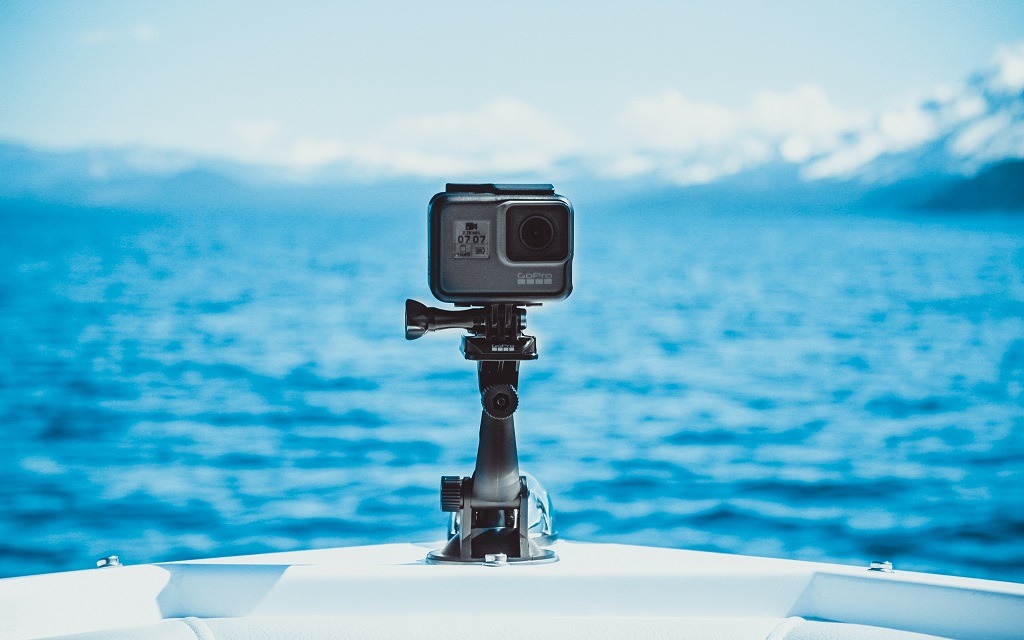
You know the ones – these are the cameras you strap to your head when you’re doing a bungee jump or white water rafting.
They’re tough, portable, light and waterproof. Basically, you can stick it in your pocket and it’ll handle everything you throw at it and allow you to record all manner of adventurous things.
Of course, the tradeoff comes in performance and image quality. Most are limited to 12 megapixel stills and feature 1/2.3″ sensors, although the Sony RX0 Mark II does go up to 1″ and 15 megapixels.
That being said, these aren’t the types of cameras that are used to take still images anyway. They’re all about the video, and most of the mid to high end models these days offer 4k video shooting at up to 30fps.
Many also come with in-built sharing features to make uploading your footage as smooth as possible, and a select few even offer live streaming!
These aren’t a replacement for a camera, but instead an addition to your arsenal if you want to share your adventures with the world in video format.
Pros
- Rugged and durable to the extreme
- Most offer good quality 4k video capabilities
- Pioneering upload and sharing options
Cons
- Not a replacement for a dedicated stills camera
- Stills image quality is generally sub-par
- Struggles in low light or challenging lighting situations
More from Click and Learn Photography…
9 best cameras for astrophotography
7 tips for black and white landscape photography
21 photography props for every genre of photography
11 best external hard drives for photographers
 |
 |
 |
 |

About Alex W.
Alex is the owner and lead writer for Click and Learn Photography. An avid landscape, equine, and pet photographer living and working in the beautiful Lake District, UK, Alex has had his work featured in a number of high profile publications, including the Take a View Landscape Photographer of the Year, Outdoor Photographer of the Year, and Amateur Photographer Magazine.
Thoughts on "6 different types of cameras for photography explained"
 |
 |
 |
 |
You can Get FREE Gifts. Furthermore, Free Items here. Disable Ad Blocker to receive them all.
Once done, hit anything below
 |
 |
 |
 |